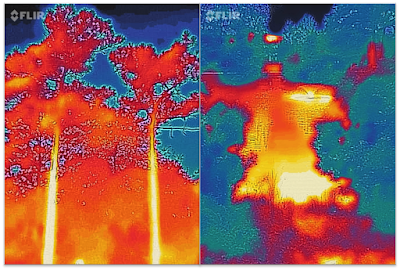Why were the trees "hot" in one image but "cold" in another?
Last week, you worked with thermal imaging cameras to observe the environment.
Many of you noted that the leaves in the photo on the left appeared "hot" while in the photo on the right, the leaves appeared "cold" but the water hot.
I asked the lender of the thermal imaging cameras, Dr. Danner in Marine Biology, why this may be. His responses are below in blue.
The first photo, the one of the trees, shows that the trunk is far warmer than the leaves. I believe this has to do with the darkness of the tree trunk as compared to reflectivity of the leaves. Is this accurate?
It may be that the darker trunks absorb more heat and are therefore warmer. Also, the tree should have greater thermal inertia because of its larger size. Therefore, trees would stay warm longer if temperatures cool (not sure if this was the case). It is true that the quality of the surface can also influence heat measurements, but I don't that should be the case here (leaves and trunks are pretty similar).The second question is in regards to a comparison of the two images. In one image (the one with the trees) the leaves are rather “warm”. In the second image the one with the fountain on campus, the water is warm but the trees are cool. Do you know why this is? That is, why are the trees one color in one image but a different color in the other?
The main difference here is simply a result of the fact that the color ramp readjusts in each image according to the range of measured surface temperatures. So, the leaves may be the exact same temperature in both images, but appear different because the scale has changed. In addition, water will appear different because it has different surface properties--these IR cameras aren't well suited for measuring water surface temperature.



Comments
Post a Comment